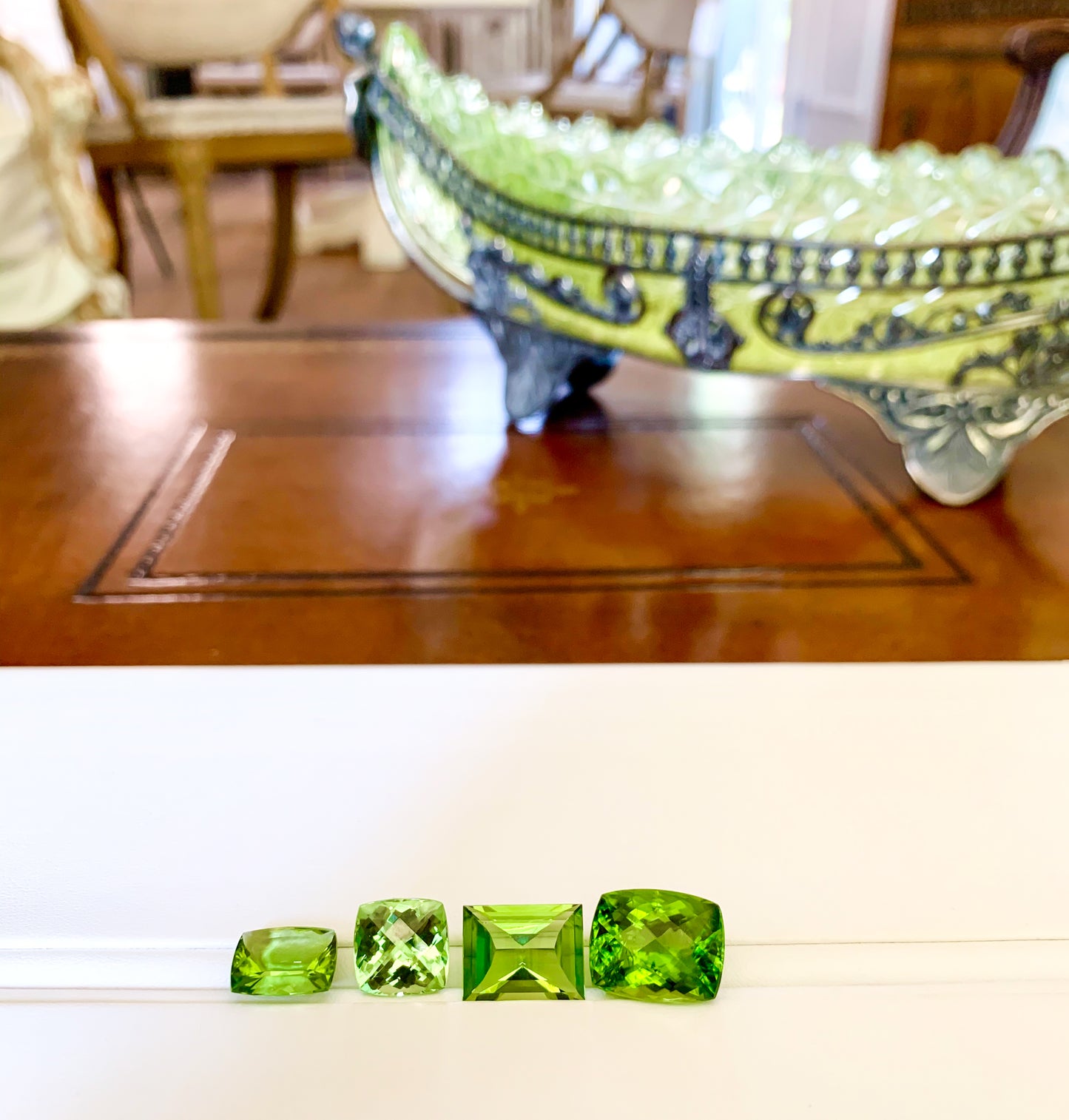
AUGUST PERIDOT: The Gem That Fell to Earth
Peridot is the most traditional of the several gems identified as the birthstone for August, and the zodiac sign Leo.
For centuries, this stone has been used as a protective talisman, supposedly shielding the owner from evil spirits and terrors of the night.
The word “peridot” is an Anglicization of the Arabic “faridat”, meaning treasure.
The stone appeared in priestly jewelry 4,000 years ago and was used on chalices and other religious objects in medieval Europe.
This green stone registers 6.5 to 7 on the Mohs hardness scale (remember that diamond is 10 on the scale, making it the hardest substance on earth).
Deep olive-green peridot are the most valuable, though the sunnier, parakeet-lime green forms are undeniably attractive.
Peridot is interesting in several ways. The first is that the peridot in a piece of jewelry may not have formed deep in the earth like most gems.
Peridot has been found on (GASP) Mars!
This is such an unusual claim that you may say “Nah.” But it’s true. In 2003, the stalwart BBC reported that outcroppings of the green gemstone were spotted from space by the NASA Mars Global Surveyor, an orbiting satellite monitoring the red planet’s surface.
The mineral deposit is located in a crater known as the Isidis basin on the Martian surface.
Peridot has also been discovered in meteors that have fallen to earth.
And, coincidence or not?
Meteor showers – “falling stars”—called the Perseids to illuminate the heavens every August.
The skies are filled with thousands of meteors, although often urban lights make it impossible for us to see them. Check online to see when the Perseids may be visible in your area. The Perseids generally peak in the middle of August, generally in the early morning hours around 3 a.m.--and the display is astonishing.
Is it possible that your peridot fell to earth in an August meteor shower?
It is.
ALOHA, AUGUST
In fact, there is a Hawaiian beach on the Papakolea coast of Oahu named for the green gemstone, where the sand shimmers grass-green from tiny particles of the gem.
It is one of only three green sand beaches in the world.
The green crystals glittering in the sand have been released by the eroded Pu’u Mahana, a volcanic cone that formed more than 49,000 years ago.
The source of peridot is the mineral called olivine, and it is a common component in the volcanic lava-flows of Hawaii.
The indigenous people of the islands honor Pele, the Fire-Goddess, as the primal force behind volcanic eruptions, and the green stones that form as the magma cools are called “Pele’s tears” by the locals.
MISTAKEN IDENTITY?
Throughout history, peridot has been confused with other gems.
An Egyptian island in the Red Sea named Topazios (now called Zabargad) was fabled for generations as the source of topaz—but we now know that the golden-green stones found there was really peridot.
Likewise, the Shrine of the Three Holy Kings in Germany’s Cologne Cathedral is decorated with 200 carats of what the builders believed were emeralds.
They’re peridot.
Some historians even speculate that Cleopatra’s famous emerald collection may have in fact been a slew of gorgeous peridot.
Who knew?
The stone is popular today for its brilliant green which, for many, symbolizes the constantly self-renewing energy of the earth and of the life-force itself.
The fact that peridot may be formed in such unusual conditions – hardened lava, and meteorites from outer space—make this green stone an extraordinary choice for anyone with an August birthday.
OR, HAVE A SPINEL MOMENT.
Spinel is now recognized as an alternate birthstone for August. In fact, the world is just now waking up to the gorgeousness and versatility of the spinel.
Like the peridot, the spinel has often been confused with more familiar stones.
The delectable, raspberry-jelly colored gem set in the center of Great Britain’s Imperial State Crown is called the Black Prince’s “ruby.”
Like many spinels mined in Southeast Asia, this gem passed through many hands as the spoils of war.
Just one thing: the fantastic, uncut 170 carats, densely pigmented red gem, received as payment in the year 1367 by Edward, Prince of Wales for a victory in battle, is, in fact, a red spinel.
It was not until 1783 that mineralogist Jean Baptiste Louise Rome identified the spinel as distinct from the ruby for which it is still often mistaken.
For centuries, the red spinel, along with all other red gems, was believed to purify the blood and ease anger.
Henry VIII wore them in a vain attempt to cure the painful symptoms of his gout.
But ruby-red isn’t the entire story. Spinel is found in a vast array of colors, from electric pink to flame orange, to purples, blues, greens, and even black.
Spinel ranks 8 on the hardness scale, making it durable enough to wear as a ring every day.
Spinel is one of the few gemstones that require no special treatment to unleash their depth and fire.
Spinel is typically unheated and untreated in any way.
In fact, sometimes the raw crystals that are unearthed at the source are so lustrous when they come out of the ground that they are called “spirit-polished.”
Spinel is one of our favorites, both as loose stone and set in high jewelry because color is our passion!
The unheated, octagonal, 8.78 carat purple spinel we call “Purple Reign” is offered as a loose stone, would make a regal addition to any collector’s cache and would be a basis for a royal piece of custom-designed high jewelry worthy of Constantine.
The sweet treat we call “Neon Now”, a demure 18 karat gold white ring clasping a shocking-pink, emerald-cut, 1.75 carat spinel sparked with bright white diamonds, is a perfectly feminine gift for an August birthday.
By the way, this particular pink spinel is part of the historic Mahenge dig in Tanzania, and thus far no subsequent deposit of pink spinel has yielded stones of equal brilliance.
Give us a call to explore the many delicious options spinel offers.
FOR OLD TIMES’ SAKE: SARDONYX
The gemstone most traditionally associated with the month of August is sardonyx.
Sardonyx is an agate, a variety of the silica mineral called chalcedony. For centuries, this banded stone was used as the basis for carving cameos and intaglios.
In ancient Rome, women wore sardonyx cameo necklaces of the goddess Venus to attract love.
Roman soldiers wore sardonyx rings and carvings of the god Mars to protect them on the battlefield.
Because hot wax doesn’t stick to this stone, sardonyx was also used for Roman signet rings to seal important documents.
Sardonyx is usually banded in dark orange, red, black and white stripes, and is often dyed to enhance its color.
While not offered as part of our catalog, a vintage sardonyx cameo or intaglio might be a unique birthday gift for someone with an August birthday.

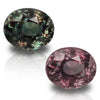 Alexandrite
Alexandrite Amethyst
Amethyst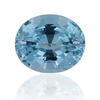 Aquamarine
Aquamarine Chrysoberyl
Chrysoberyl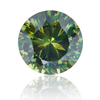 Demantoid
Demantoid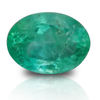 Emerald
Emerald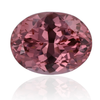 Garnet
Garnet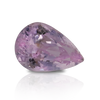 Kunzite
Kunzite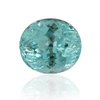 Paraiba
Paraiba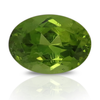 Peridot
Peridot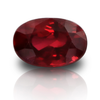 Ruby
Ruby Sapphire
Sapphire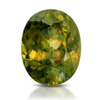 Sphene
Sphene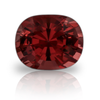 Spinel
Spinel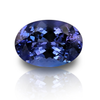 Tanzanite
Tanzanite Topaz
Topaz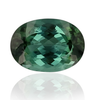 Tourmaline
Tourmaline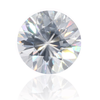 Zircon
Zircon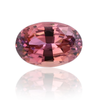 Zoisite
Zoisite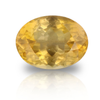 Rare Gemstones
Rare Gemstones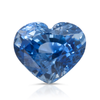 Heart Shape
Heart Shape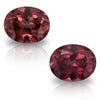 Matched Duo
Matched Duo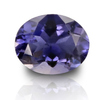 Everyday Candy
Everyday Candy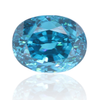 Insta Therapy
Insta Therapy Mini-Splurge
Mini-Splurge